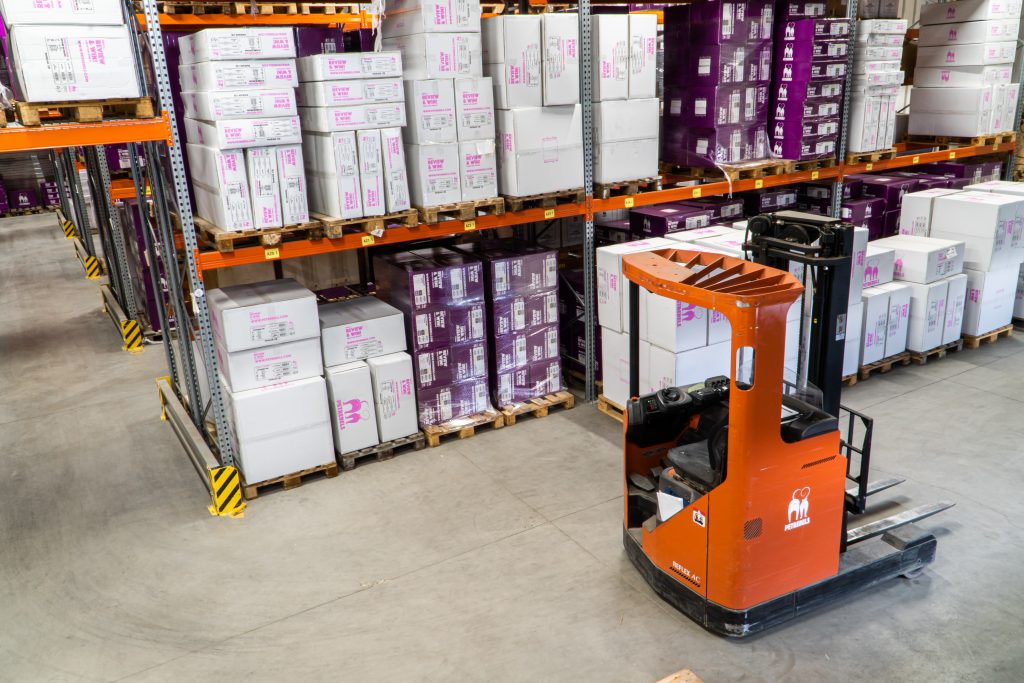As more and more eCommerce stores are popping up online, the competition is only increasing every day. To be successful, every function within an organization must learn to work in tandem in order to be efficient in meeting customer demands and expectations. A particularly important aspect of this is the Inventory Management (IM) process within the Supply Chain Management (SCM) of the organization as it involves regulating all the processes involved from the time the item i.e. “inventory” is received until the time it has been sent out to the customer.
What is inventory management Process?
Inventory Management is the efficient tackling and “management” of an organization’s inventory goods from procurement through to the final delivery, across its various stages i.e. raw material, production, finished goods.
The approach that each organization adopts in managing its inventory has a huge impact across a number of different business processes as they have the power to enhance or deplete the company’s bottom line. It has therefore become increasingly important that businesses choose, determine and apply the right technique, along with investing in inventory management software (Check out: www.zapinventory.com) that can result in making the process efficient, productive and profitable.
How does it impact your organization?
While good, efficient inventory management can drive up profits for the business, even trivial goof-ups in processes can burn down your revenue and impact the bottom line. Organizations have three levels, namely structure, process and system, each of which is important to the overall functioning of the organization. In order, the first level determines the crucial elements of the business, the second sets out the steps to be followed, and the third align the elements and solves the problems. Inventory management works within each one of these elements.
No matter the size, no business is shielded from the negative impacts of poor inventory management. When supply chains are mismanaged, there can be some serious consequences. If you have too large an inventory or are using outdated methods to track your goods, or don’t have adequate reports and forecasting, you better get hold of the rope before it’s too late.
Poor inventory management can kill your brand. We’ve read about catastrophic inventory mistakes by huge brands like Nike, Target and KFC, but if you are not as big as these guys, this is something that you just cannot afford.
Inventory management process

The inventory management process apparently looks pretty straightforward, and not complex at all. As you dive deeper and dissect each function, you begin to realize just how extensive it is. Although businesses vary in their operations, the general process of inventory management for most businesses is somewhat as follows:
- Receive
The first step in understanding what is inventory management process starts from the moment the goods are received by the business into their warehouse. These can be raw materials, components, indirect materials, and finished goods for resale. Businesses use software with warehouse management capabilities to make the process streamlined. - Review
Once received, the goods are reviewed, sorted and stored in designated areas. While bigger organizations may be able to afford a separate unit for this, the smaller ones make do with the warehouse as a stocking area. The goods are tagged with SKUs (Stock Keeping Unit) and barcodes for tracking. - Monitor
Now that all the goods are accounted for, the inventory levels are monitored regularly through a combination of physical and automatic inventory counts. Doing this ensures everyone is updated on the available stock and prevents chances of a stock out, duplicate orders, risk exposures, etc. We will discuss more about the techniques of inventory management in the next section. - Order
Customers place orders in accordance with the products offered by the store either via the eCommerce store or physical outlet through the POS (Point of Sale). The order is then processed for approval. - Approve
Once the order is received, it is approved against the sales receipt, purchase order, etc and the vendor moves it forward for order fulfillment.
Check out ZapERP for order management - Dispatch
After an order is approved, it is then prepared for dispatch to production, retailer, or to the final consumer. Implementing an order fulfillment system makes the process easier to manage and saves you a bunch of time. - Update
Every time any inventory is dispatched out of the warehouse, the records must be updated and shared with the concerned personnel in order to avoid overstocking and understocking of inventory. - Restock
Depending on the demand and supply, the inventory needs to be restocked as needed, taking inference from the inventory levels as on the inventory management system. More on these techniques in the next section, keep reading!
What are the different techniques?
Most businesses have physical inventory of some kind and they need reliable tools to maintain and manage the stock of these. This can be done by implementing an effective inventory management process and achieve maximum workflow efficacy, optimal return on investment (ROI), and minimum expense. Let’s take a look at the core inventory management techniques:
- Inventory Control
This is the process of maintaining an optimal level of inventory i.e. keeping in stock enough items to meet customer demands promptly while keeping the cost of holding the stock low. While it sounds straightforward, it can actually be quite difficult to achieve. This term is often used interchangeably by companies with Inventory Management.
Read our blog on Inventory Management vs Inventory Control - LIFO & FIFO
These valuation methods are the accounting components of inventory management systems. Last-In-First-Out (LIFO) is a method where the goods that came in the latest are dispatched the soonest and First-In-First-Out (FIFO) is a method where the oldest goods are sent out the soonest. They detail the actual value of inventory to the company’s bottom line. - ABC Analysis
This technique determines the value of the inventory items based on their importance to the business and quantity.
“A Goods” are low in quantity but high in value.
“B Goods” are moderate in quantity and in value.
“C Goods” are high in quantity but low in value. - Stock Review
A traditionally manual and physical process of comparing current levels of stock inventory with estimated futures needs, it is also prone to human error, time-consuming and a labor-intensive process. With time, stock review has witnessed automation technology that allows inventory manager to set their desired minimum stock level and reorders goods automatically as and when needed. - Just in Time (JIT)
As the name suggests, the Just-In-Time method relies on precision logistics to ensure that the inventory goods arrive ‘just in time’ to meet the demand of customers. This is great in terms of reducing wastage and occupying up unnecessary storage, but it is data-intense and critical that one must have accurate knowledge of different factors and tools required to pull this off. - Cycle Counting
This is a perpetual inventory auditing procedure during which specific portions of inventory are counted at specific locations on specific days. This is also known as cycle inventory, and it ensures every item is counted at least once in an accounting period (usually one year). It is different from traditional physical inventory where they pause operations while all items are counted.
Benefits of an inventory management system
In order to deploy an efficient inventory management process, you will need a good inventory management system (IMS). But before we list the benefits of an IMS, let’s briefly touch upon the advantages of inventory management.
- Better accuracy of inventory
- Avoid overstocking & understocking
- Lowered expenses
- Improved productivity
- Better insights
- Increased profits
- Greater transparency & clarity
- Better customer experience
If these were lucrative enough, here are the benefits of having an inventory management system. Even better if it is integrated with an ERP!

- Simplified inventory management
This is quite possibly the best on the list. The constant process of procurement, logistics, stocking, order management and fulfillment is overwhelming. The biggest advantage of using inventory management software is that it makes the process a whole lot simpler and easier. - Reduced manual effort & inaccuracies
Manual work processes call for mistakes, or as we term them, human errors. It is inevitable. Inventory management includes some complex calculations and processes that can take up a lot of man-hours that an IMS can do efficiently and accurately in a matter of a few minutes. Additionally, it automates all the data collection and tracking processes, hence, leaving no room for errors and inaccuracies such as data duplicity. - Reduced overselling risk
A lot of businesses face a ban from marketplaces like Amazon and eBay for overselling their products. Overselling happens when the stock is not updated and the customer places an order for a product that is stocked out. It also results in loss of control and disappointed customers. A system ensures your stock count is updated in real-time and avoids the repercussions of a situation otherwise. - Leverage automation
Tasks like RFID and barcode scanning speed up functions like stock taking, receiving, and fulfillment. Using an IM software for these not only reduces manual errors but also frees up your staff from repetitive tasks that take up unnecessary time. - Cuts cost & increases profits
This is the most lucrative point on the list – profits. Streamlining your inventory management process through a proper system not only eliminates indirect inventory costs but also yields further cost savings. It can help shorten your supplier lead time and reduce excess & obsolete stock in addition to the biggest saving that comes from automation. You can increase profit by using your IMS to forecast demand and stock accordingly so that you are never stocked out during heavy demand seasons for your products. - Data-driven decision making
Inventory management systems capture information from multiple data points. Leverage this capability of your IMS to make data-driven, high-quality inventory decisions that help you reduce costs and save time. - Enhanced productivity
The different analytics in your IM software can help you identify which of your products are selling faster, which of your sales channels are bringing in the most sales and which aren’t. Use this to make more intelligent decisions like where you should focus more and which areas need improvement. - Saves precious time
It is no surprise that computers, or in this case software are capable of working multiple times faster than humans. When you rely on an inventory management software, processes are faster, more accurate and more reliable, task redundancy & data duplicity are reduced, a great deal of direct and indirect cost is saved, and so is your valuable time. - Improved forecasting
When you use an IMS, it can provide insight into different trends through the data collection and analysis over a period of time. Once you identify those trends and understand them, you can improve stock forecasting substantially. - Inventory optimization
One of the common challenges by all businesses who deal with some physical inventory is overstocking & understocking. Determining and managing the right balance is key. Fortunately, a robust IMS can help you identify stocks that are low in quantity in real-time so you can order ahead and avoid a stockout, and also do away with the need to overstock. - Better business negotiations
An IMS has features of batch tracking which helps increase traceability and access valuable information so you can interact better with potential suppliers, determine which of them are beneficial and which need improvement. - Compliance with GAAP
Valuing your stock correctly and accurately is mandatory to induce financial transparency. Most IMS offer the accuracy required by the Generally Accepted Accounting Principle i.e. GAAP. - Improved overall visibility
As the business grows, things tend to get buried over time and tend to lose sight in the process. In the event such as a product recall, it can be a mammoth task and may take countless hours to pull out the products without a proper batch tracking function. This is definitely not ideal for running a business. Digital IMS allows inventory managers to fetch data for products by date & location using serial or identification numbers. - Data security
Not everything is meant for everyone. When you run a company, hierarchy is important, and so is defining roles and access for your team. In the absence of a system, the lines may get blurry and there may be an absence of accountability. When you use an IM system, you can define roles, and also access for each user. This way, you ensure that only the intended person is able to access the data. The biggest benefit is that it provides security on all levels.
Challenges you can expect
Like almost everything great, inventory management systems also come with a few challenges. Watch out for these challenges when building out your inventory management process:

- Can be complex
The change from manual to automatic may be good, but can be complex. Seeing as inventory management has so many processes and components, you may find it a bit intense, and it might take some getting used to. It is important that you get your team committed to understanding, as well as using the software. It may take up some time initially for everyone to get accustomed to the platform. That said, once you have had the chance to get to know the working of the platform, it is sure to make your life easier in the long run. - Risk factors
Although the risk due to errors and inefficiencies are reduced due to formalized processes and automated workflows, you need to keep an eye on your inventory management process for potential improvements and errors, in order to keep risks at bay. It might be advisable to connect your IM process to supply chain management (SCM) and quality control (QC). This would help guard your reputation and bottom line.
Another possible risk could be the system crashing unexpectedly. However, this problem can be eradicated by choosing a software platform like ZapERP inventory management, which is a cloud-based platform. So, in the event that this should happen, all your data will be completed safe as they are all stored in the cloud. - Resource intensive
Along with the potential initial investment in acquiring the software, you can expect to spend a considerable amount of time and effort in achieving buy-in from senior management and also the other members of the company as a whole. Add to that the cost of training and education for the software before you are able to “go live” i.e. deploy the software operation-wide. - Might be expensive
This one is particularly relevant to smaller businesses. The cost associated with purchasing and deploying an IM software can be quite daunting. Nonetheless, the initial investment more than pays off in the form of improved customer loyalty and increased profits. One of the ways of reducing the cost is to choose a platform that is hosted on the cloud. Not only is the risk lower, but it costs a fraction of what it would otherwise cost you if you were to develop one in-house.
BONUS: How to develop an efficient inventory management process?
There are countless options out there, but your business is not like that of your next-door neighbour’s. You need to carefully analyze and evaluate your goals and mission, in order to determine the key requirements that will help you achieve them. Check out this mini checklist –
- Decide on a budget
As we have mentioned in this blog before, you can expect to incur some noticeable costs when choosing and implementing an IM software. It helps to chalk out the estimated direct as well as indirect costs and decide your comfort level. If you choose a software that connects with procurement, ERP (Enterprise Resource Planning), and accounting software, it will help connect the dots financially. Remember, although the initial investment may seem like a big number apparently, the benefits you will reap will be far more in the long run.
- Figure out logistics and storage
The type, location and number of warehouses you will require will depend on the size of your industry and company. Choose an IMS that makes it easier to coordinate across all channels seamlessly. - Put yourself first
One size does not fit all. You need to weigh all the available options and zero in on the one that checks all your boxes (requirements) – or at least the one that checks most of them. Take into account the purchase cost, onboarding cost, switching cost (yes, this is important too as it is going to be a heavy factor should you decide to switch to an alternative tool) etc. Most options out there provide a free trial for a set number of days; take advantage of that and try out all those that appeal to you before you close in on one.
Inventory management does not have to be frustrating
It may seem like managing your products is a task bigger and more overwhelming than actually selling them to potential customers. We hope this article has been successful in taking away some of the frustration by being helpful in providing information on things to look out for when choosing the software, the benefits and challenges of an IMS. Investing in the right IM software can ensure you have it readily available whenever, wherever, taking care of not only your inventory but also churning out expenses and inefficiency out of your organization.
Check out our other blogs for more info on Inventory management, multi-channel selling, POS and so much more. If you are an eCommerce seller, you need to subscribe to this blog! To make the deal sweeter, we’ll even give you 2 weeks of extra trial when you sign up on ZapERP. Just screenshot this section and email us.
Happy selling!
 Start using ZapInventory today
Start using ZapInventory today
